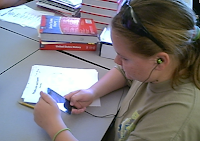
I recently entered a competition in which I submitted some lesson plans that use technology. The idea was that a certain number of the "best" lessons would earn a significant sum of money for their school to spend on technology. I don't usually get into these things, but the prize was grand enough that it definitely seemed worth the hour or two it would take to sort through some old lessons and upload them to the contest site. I obviously use technology a lot in my classes, and have a ton of lessons to draw from - so there was nothing new I would have to create. My thinking was, I'd submit 10 of what I considered my most successful lessons. Not my
flashiest lessons, just my most successful. I wasn't sure if I'd win - I knew that was a crap shoot.
I didn't win.
The winners submitted lessons that ultimately involved big video productions of what can only be described as
technology orgies. The winning entries had a mammoth project theme. There was a teacher at the front of the room doing amazing magic on an interactive white board, students were doing things on the whiteboard, students were doing things on their computers, they were videoing each other, they were working together on the laptops, they were interviewing each other with podcasting mics, and it was all put together in a beautifully edited iMovie production complete with music and transitions so that the contest judges could see all this exciting classroom action. It was definitely awesome stuff.
It did not escape my notice that the winning lessons were videos typical of the kind of lessons that are often presented to teachers as the "ideal" or model of what technology in the classroom should look like. No wonder some are afraid - those videos made
me afraid!
I wasn't surprised that I didn't win - I just had my fingers crossed anyway. The real surprise to me was the feedback I got on the lessons I submitted. Here is the gist of those comments;
"The students are not learning about the technology." "You do not say how the use of technology in this lesson creates learning." "This lesson could have been taught without technology."
...and so on -
ish.
The first thing I realized was that I guess I could have explained some things more carefully in the plans I submitted - I just submitted the plans as I had originally written them for myself.
But the more important thing I realized was that we are entering a phase with technology in instruction where many teachers who have been using it for awhile have integrated it into their teaching style - it's part of our methodology.
In my classroom,
the technology is not the thing. Make no mistake, my students use technology every single day - I teach in a 1:1 school. They use Web 2.0 tools to create content about what they are learning in class. The make short videos of what they have learned and post them to teach their classmates a quick lesson. They routinely share Google Docs online with classmates to work collaboratively. They email and chat online with me outside of school about assignments. They blog. They write with embedded links to enhance and deepen their work. They keep their school work organized by using digital portfolios. They have an expectation that I will bring experts into the room through video and Skype. And so on.
However, my students don't come into my classroom every day saying, "Yay - we get to work on a big project!" I like projects, and sometimes we do projects. But in my classroom, the content - the learning is the thing. The technology just helps us to do that
a lot better for
every student.
I like the analogy of classroom technology and cell phones. Our cell phones are not some golden toy (unless we are using them to kill time in an airport playing games on them). We need them. We keep calendars on them, we keep notes on them, and - by the way - we communicate with them. Many of us have incorporated them into our lives to the point that we cannot imagine going without them. Of course we could, but our life would be missing some connections, some organization, and some powerful and useful tools that we had become accustomed to having at our fingertips, in our purses and pockets.
Remember your first cellphone? Some people are still viewing technology in the classroom with the same kind of awe and wonder. The reality is, cell phones are now ubiquitous. But much of the perception of classroom technology is still in the "first cell phone" phase.









